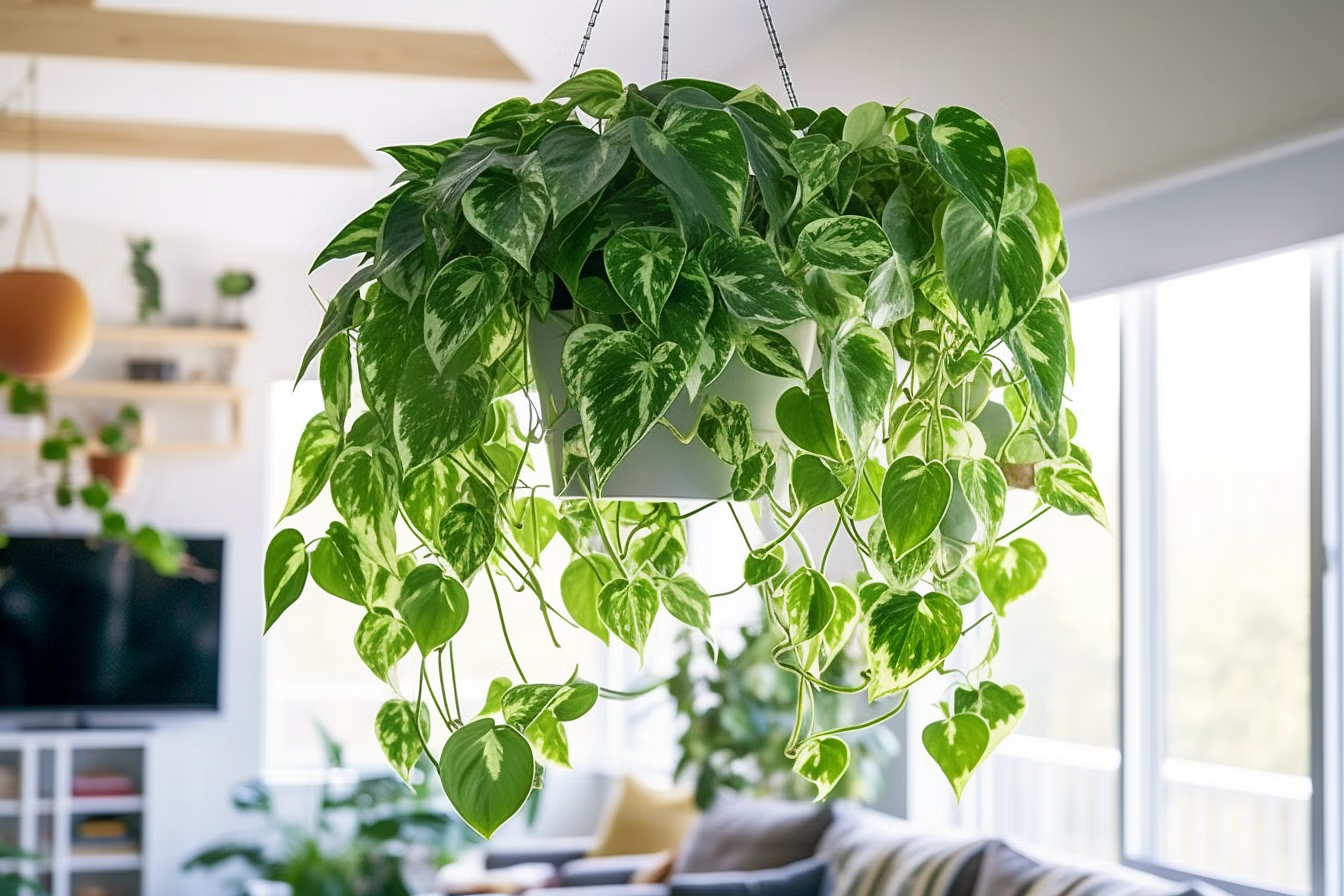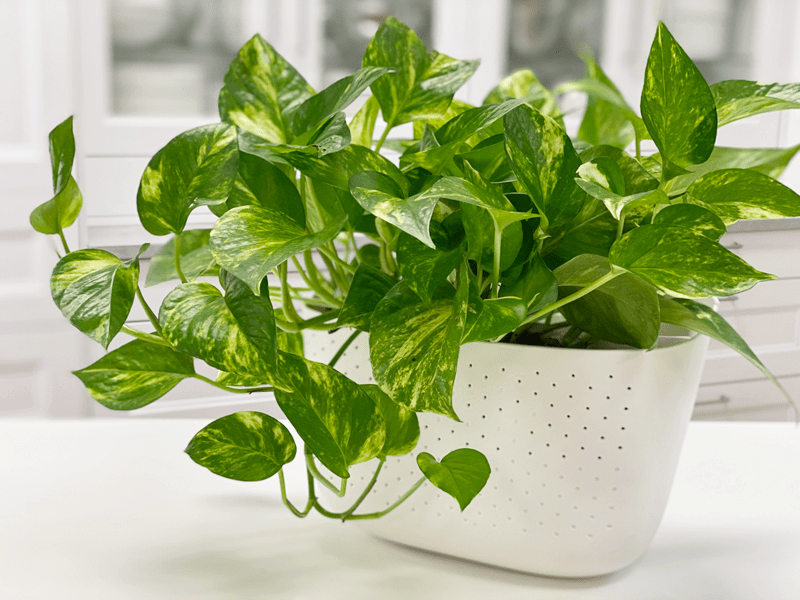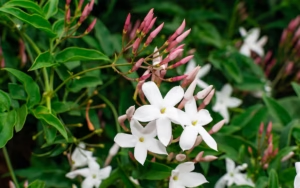Pothos, also known as Epipremnum aureum or “devil’s ivy,” is one of the most popular houseplants for both beginner and experienced plant enthusiasts. With its vibrant green foliage and easy-to-maintain nature, Pothos adds a touch of elegance to any indoor space. In this comprehensive guide, we’ll explore everything you need to know about growing and caring for Pothos, including different types, pruning, propagating, potting, common pests, and frequently asked questions.
Pothos Care
Pothos is famous for its adaptability and resilience. Whether you’re a seasoned gardener or someone with a “brown thumb,” these plants are forgiving and thrive in a variety of conditions.
Light Requirements
Pothos can grow in a range of lighting conditions, from bright, indirect sunlight to low-light environments. However, for vibrant and healthy growth, bright, indirect light is ideal. Variegated varieties, such as Golden Pothos and Marble Queen, require more light to maintain their patterns. Avoid direct sunlight, as it can scorch the leaves.
Watering
Pothos prefers slightly dry soil over being overly saturated. Water the plant when the top inch of the soil feels dry to the touch. During warmer months, you may need to water more frequently, while in cooler months, watering once every 10-14 days is often sufficient. Always ensure the pot has drainage holes to prevent root rot.
Temperature and Humidity
Pothos thrives in temperatures between 65°F and 85°F (18°C to 29°C). While it can tolerate lower temperatures, anything below 50°F (10°C) may cause damage. Humidity is not a major concern, but higher humidity levels encourage faster growth and lusher foliage. If your home is particularly dry, consider misting the leaves occasionally.
Soil
Use a well-draining, all-purpose potting mix for your Pothos. You can add perlite or sand to improve drainage if needed. These plants are not overly fussy about soil quality, but a nutrient-rich mix helps boost growth.
Fertilizing
Feed your Pothos once a month during the growing season (spring and summer) with a balanced liquid fertilizer diluted to half strength. Reduce feeding in the fall and winter when the plant’s growth naturally slows.
Types of Pothos
Pothos comes in a variety of types, each offering unique aesthetics that make them a favorite for plant enthusiasts. Here’s a closer look at some popular varieties:
Golden Pothos
This classic variety features heart-shaped green leaves with golden-yellow variegation. It’s the most common type and is exceptionally hardy, thriving even in low-light conditions. Golden Pothos is often used in offices and homes as it requires minimal maintenance.
Marble Queen Pothos
Known for its stunning marbled foliage, the Marble Queen Pothos showcases a mix of creamy white and green patterns on its leaves. This variety grows slightly slower than others but is worth the wait for its decorative appeal. It thrives best in bright, indirect light to maintain its variegation.
Neon Pothos
The Neon Pothos stands out with its vibrant, lime-green leaves that almost seem to glow. Its striking color adds a pop of brightness to any indoor setting. This type requires slightly more light than other varieties to maintain its vivid coloration.
Jade Pothos
Jade Pothos is a solid green variety with no variegation. Its simplicity and rich, deep green foliage make it a perfect choice for darker corners where other plants may struggle. It’s incredibly resilient and easy to care for, making it ideal for beginners.
Satin Pothos (Scindapsus pictus)
Often mistaken as a Pothos, Satin Pothos is a different species but shares similar care requirements. Its dark green, velvety leaves adorned with silver speckles are eye-catching and unique. It prefers slightly higher humidity levels and indirect light.
Cebu Blue Pothos
The Cebu Blue Pothos is known for its metallic blue-green leaves, which develop a slightly elongated shape as they mature. This variety is less common but highly prized among plant collectors for its striking appearance and moderate growth rate.
Manjula Pothos
Manjula Pothos has wide, heart-shaped leaves with a mix of white, cream, and green variegation. It’s a patented variety and tends to grow more slowly, but its intricate patterns make it a stunning addition to any collection.
Each type of Pothos has its own charm, so choosing the right one depends on your aesthetic preferences and the environment you can provide. With so many options, there’s a Pothos variety to suit every plant lover!
Pruning
Pruning is an essential part of Pothos care to maintain its shape and encourage healthy growth.
Why Prune?
Pruning removes dead or yellowing leaves and promotes fuller growth. It’s also a great way to control the plant’s size, especially if it becomes too long or leggy.
How to Prune
- Use clean, sharp scissors or pruning shears.
- Trim just above a node (the point where a leaf or root grows from the stem).
- Remove any damaged or discolored leaves.
Prune during the growing season for the best results. Regular pruning not only enhances the plant’s appearance but also provides cuttings for propagation.
Propagating Pothos
One of the joys of owning a Pothos is how easily it can be propagated. You can create new plants from cuttings, making it a budget-friendly way to expand your indoor jungle.
Steps to Propagate Pothos
- Choose a Healthy Stem: Select a vine with at least 3-4 leaves and visible nodes.
- Cut the Stem: Using clean scissors, cut the stem just below a node.
- Prepare for Rooting: Remove the leaf closest to the node to prevent it from rotting in water or soil.
- Rooting in Water: Place the cutting in a glass of water, ensuring the node is submerged. Change the water every 5-7 days. Roots usually develop within 2-4 weeks.
- Plant in Soil: Once the roots are at least an inch long, transfer the cutting to a pot with fresh soil.
Alternatively, you can root the cutting directly in soil, but be sure to keep the soil moist until roots establish.
Potting and Repotting Pothos
Pothos is a fast-growing plant and may need repotting every 1-2 years. Repotting ensures that the roots have enough space and prevents the plant from becoming root-bound.
When to Repot
Repot your Pothos when:
- Roots are coming out of the drainage holes.
- Growth has slowed down significantly.
- The soil is compacted and no longer retaining moisture well.
How to Repot
- Choose a pot that’s 1-2 inches larger in diameter than the current one.
- Fill the new pot with fresh, well-draining soil.
- Gently remove the plant from its old pot, being careful not to damage the roots.
- Place the plant in the new pot and fill in with soil around the roots.
- Water thoroughly and place it back in its preferred spot.
Common Pests and Plant Diseases
While Pothos is relatively low-maintenance, it’s not completely immune to pests and diseases. Here are some common issues to watch for:
Pests
- Spider Mites: These tiny pests can cause webbing on the leaves. Treat with insecticidal soap or neem oil.
- Mealybugs: White, cotton-like clusters on leaves and stems indicate mealybugs. Remove them with a cotton swab dipped in rubbing alcohol.
- Scale Insects: These appear as small, brown bumps. Use a gentle insecticide or manually remove them.
Diseases
- Root Rot: Overwatering often leads to root rot. Prevent this by ensuring proper drainage and watering only when the soil is dry.
- Leaf Spot: Yellow or brown spots may indicate a fungal infection. Remove affected leaves and improve air circulation around the plant.
Common Problems With Pothos
Even though Pothos is a hardy plant, you may encounter a few problems. Here’s how to solve them:
Yellowing Leaves
- Cause: Overwatering or underwatering.
- Solution: Check the soil moisture and adjust your watering routine accordingly.
Leggy Growth
- Cause: Insufficient light.
- Solution: Move the plant to a brighter spot with indirect sunlight.
Brown Leaf Tips
- Cause: Low humidity or over-fertilizing.
- Solution: Increase humidity levels and reduce fertilizer use.
FAQ
How Often Should I Water My Pothos?
Water your Pothos when the top inch of the soil feels dry. This could be once a week in warmer months and less frequently in cooler months.
Can Pothos Grow in Low Light?
Yes, Pothos can tolerate low light, but it will grow more slowly. Variegated varieties may lose their patterns in very dim conditions.
Is Pothos Toxic to Pets?
Unfortunately, Pothos is toxic to cats and dogs if ingested. Keep it out of reach of pets and children.
How Fast Does Pothos Grow?
Pothos is a fast-growing plant, especially in optimal conditions. You can expect noticeable growth within a few weeks during the growing season.
Can Pothos Be Grown Outdoors?
Yes, in warm climates (USDA zones 10-12), Pothos can be grown outdoors in shaded areas.










